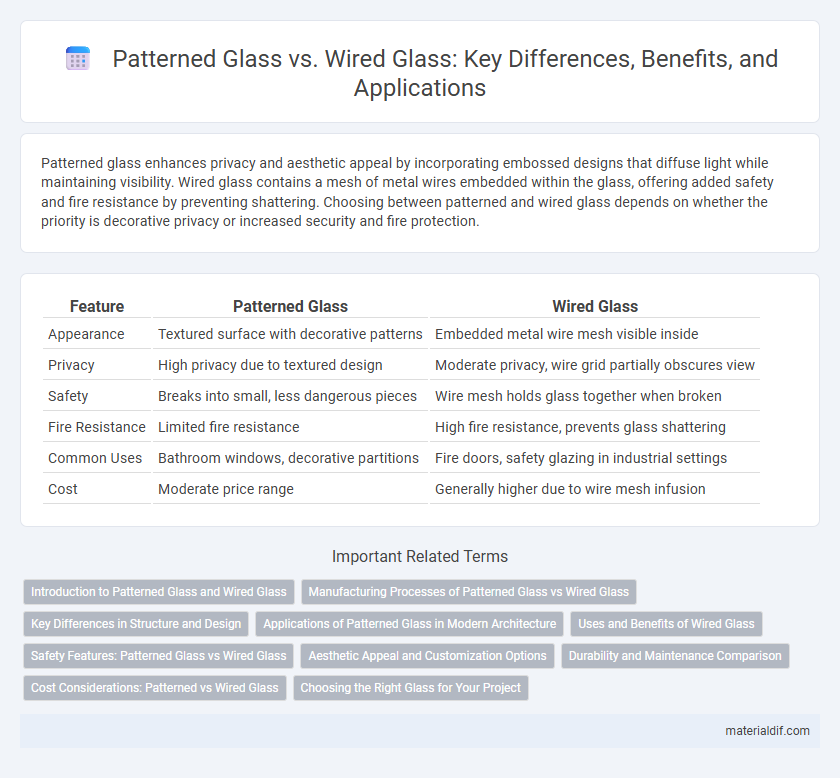Patterned glass enhances privacy and aesthetic appeal by incorporating embossed designs that diffuse light while maintaining visibility. Wired glass contains a mesh of metal wires embedded within the glass, offering added safety and fire resistance by preventing shattering. Choosing between patterned and wired glass depends on whether the priority is decorative privacy or increased security and fire protection.
Table of Comparison
| Feature | Patterned Glass | Wired Glass |
|---|---|---|
| Appearance | Textured surface with decorative patterns | Embedded metal wire mesh visible inside |
| Privacy | High privacy due to textured design | Moderate privacy, wire grid partially obscures view |
| Safety | Breaks into small, less dangerous pieces | Wire mesh holds glass together when broken |
| Fire Resistance | Limited fire resistance | High fire resistance, prevents glass shattering |
| Common Uses | Bathroom windows, decorative partitions | Fire doors, safety glazing in industrial settings |
| Cost | Moderate price range | Generally higher due to wire mesh infusion |
Introduction to Patterned Glass and Wired Glass
Patterned glass features textured surfaces created through rolling or pressing techniques, enhancing privacy and decorative appeal while allowing light transmission. Wired glass incorporates a metal mesh embedded within the glass, providing increased fire resistance and safety by preventing shards from dispersing upon breakage. Both types serve functional roles in architectural and safety applications but differ significantly in appearance and purpose.
Manufacturing Processes of Patterned Glass vs Wired Glass
Patterned glass is produced by pressing molten glass onto engraved rollers that imprint textured designs, creating various patterns for decorative or privacy purposes. Wired glass manufacturing involves embedding a steel wire mesh into molten glass during the float glass process to enhance fire resistance and safety. Both processes require precise temperature control and cooling techniques to ensure structural integrity and performance specifications.
Key Differences in Structure and Design
Patterned glass features textured surfaces created through roller or casting processes, offering decorative designs that diffuse light while maintaining privacy. Wired glass incorporates embedded metal wire mesh within the glass layers, enhancing fire resistance and structural stability by preventing shattering during high heat exposure. The primary structural difference lies in patterned glass's focus on aesthetics and light control, whereas wired glass prioritizes safety and fire protection through its internal wire reinforcement.
Applications of Patterned Glass in Modern Architecture
Patterned glass enhances modern architecture by providing both privacy and natural light diffusion, making it ideal for office partitions, shower enclosures, and decorative facades. Its textured surfaces reduce glare and improve aesthetics while maintaining structural integrity compared to wired glass, which is primarily used for safety and fire resistance. Architects favor patterned glass for its versatility in creating visually appealing spaces without compromising light transmission in commercial and residential projects.
Uses and Benefits of Wired Glass
Wired glass is primarily used in fire-rated doors, windows, and partitions due to its enhanced safety features and ability to contain flames and smoke during a fire. Its embedded wire mesh provides structural integrity, preventing glass shattering and offering increased security and impact resistance. This makes wired glass ideal for industrial, commercial, and institutional environments where fire protection and safety compliance are critical.
Safety Features: Patterned Glass vs Wired Glass
Patterned glass offers safety by providing privacy and diffusing light while maintaining moderate impact resistance, making it suitable for interior partitions and decorative applications. Wired glass incorporates embedded metal wire mesh that enhances fire resistance and holds shattered glass fragments together, reducing the risk of injury during breakage in hazardous environments. Both types improve safety, but wired glass excels in fire-rated installations, whereas patterned glass prioritizes aesthetic with basic safety features.
Aesthetic Appeal and Customization Options
Patterned glass offers diverse textures and intricate designs that elevate aesthetic appeal, making it ideal for decorative applications in interior spaces. Wired glass features embedded metal mesh, providing a distinctive industrial look while enhancing safety but with limited design customization. Customization options are broader for patterned glass, allowing various patterns, colors, and finishes tailored to specific architectural styles.
Durability and Maintenance Comparison
Patterned glass offers moderate durability with a textured surface that helps obscure visibility while resisting minor scratches and dents, requiring minimal maintenance due to its smooth finish. Wired glass, embedded with a metal mesh, provides enhanced durability and fire resistance but demands more frequent inspections to prevent corrosion of the wire mesh and potential cracking. In terms of maintenance, patterned glass generally requires less care, whereas wired glass benefits from regular cleaning and monitoring to maintain safety standards.
Cost Considerations: Patterned vs Wired Glass
Patterned glass typically costs less than wired glass due to simpler manufacturing processes and lower material expenses. Wired glass involves embedding a metal mesh within the glass, increasing production complexity and overall price. For budget-sensitive projects requiring enhanced safety and aesthetics, patterned glass offers a more affordable option compared to the higher cost wired glass.
Choosing the Right Glass for Your Project
Patterned glass offers decorative textures and privacy, making it ideal for interior partitions and bathroom windows, while wired glass provides enhanced safety with embedded wire mesh that prevents shattering, commonly used in fire-rated doors and industrial settings. Selecting the right glass depends on balancing aesthetic preferences with safety requirements and project-specific regulations. Understanding the functional benefits and compliance standards of patterned versus wired glass ensures optimal performance and design integration for your construction or renovation project.
Patterned glass vs Wired glass Infographic

 materialdif.com
materialdif.com